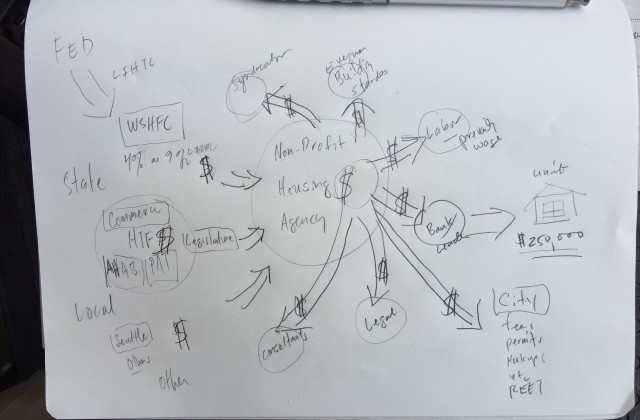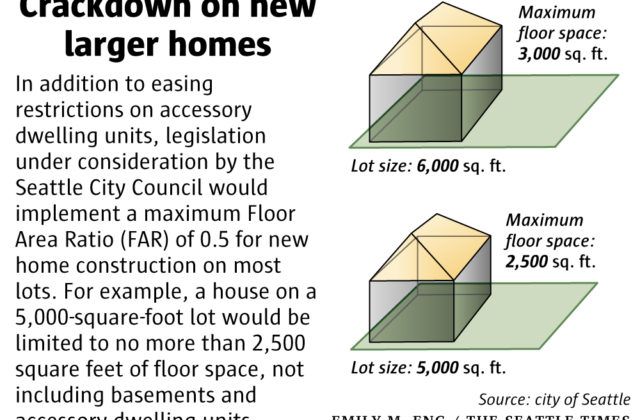Document Disclosure Drama: “Engaging its author is a trap and futile.”
Have you seen those weird ads saying, “Enter your name into this site and hold your breath!” Or whatever. The idea is that by searching for your own name on the internet your deepest and most horrible secrets or those of others might come out. Welcome to the public disclosure request. The PDR as it is called isn’t as fast but sometimes it can be as troubling or satisfying depending on your point of view. I queried the Washington State Housing Finance Commission using my name as a search term seeking all public documents. I’m finding lots of good stuff. This is a bit of tease. I’ll post more.
A while back, I wrote about How Trump Might Drain The Low Income Housing Tax Credit Swamp. This post caused a lot of heart burn, which is, to use the vernacular, cute. Cute because there was never any chance anyone was going to listen to me; but boy it rattled people. So I’m going to share some of the behind the scenes chatter among the very wealthy lawyers and non-profits that happened because of that post.
Meanwhile check out this document, an e-mail from Marty Kooistra to Al Levine. Kooistra is the director of the Housing Development Consortium, or HDC, the group that has succeeded in getting the City of Seattle to use its muscle to extort hundreds of millions of dollars for his members. I hope the HDC sues me over that word, extort. I’d love an open debate on that word in relation to the Mandatory Housing Affordability (MHA) program. And Al Levine is a former executive at the Seattle Housing Authority. Both men are good people and, I believe, driven by the best intentions. Anyway, here’s their e-mail exchange about me.
Odd. I had lunch with Kooistra, one of his board members and mine years ago in an effort to find common ground on costs to build housing. For many months, one of his board members was invited to our regular meetings with City departments to talk about costs. I also published on my little read blog, a post by Kooistra and Rachel Meyers about how the legislature should put more money into the Housing Trust Fund. Kooistra has been bitter ever since.
And Al Levine. Here’s the e-mail I sent him in advance of sharing these documents widely — I mean in a place where there might be a few more readers.
Hello Al,
I’ve always liked and respected you and still do.I’m going to start sharing the fruits of a public disclosure request that I made from the WSHFC.
You popped up! See the attached.
Help me understand how you reconcile all this. You know I’m right, don’t you. Marty does too.
Why can’t you folks just work with us to lower costs? Why do you insist on going after me? Why am I the problem and not zoning, and design review and all the other regulatory overreach? Why do you allow for profit groups like Pacifica and Beacon (not to mention contractors etc) to get more and more money and say nothing about that?
I really believe you are a good person and well intended. You’re probably at least 10 times smarter than me. What do I have to do to get your help instead of your opposition?
I need it. We need to turn this thing around. And if you forward this to your buddies with government accounts I may get my hands on it.
How about an honest and not passive aggressive answer?
I hope all is well with you, Al.
Roger–
Why do all this?
Well, as we speak all across this city and region there are people who are looking at their calendars and their bank account. Those people I am thinking of are wondering where the money is going to come from to pay for rent. These people live in public housing, non-profit housing, or for profit housing. What they share is a need for certainty, a certainty that many of us take for granted. For many others it is too late. They live in their car, or with an abusive partner, or outside.
Being liked and adulated has its special pleasures. Being loved and respected and listened to feels good. Making people unhappy and upset has its pleasures as well, especially when it is in the service of trying to motivate them to do the right thing, reduce housing costs across the whole economy and increase overall supply. Will this backfire on me? Will someone come after me one day? Probably. Nobody likes to be criticized, even on a little read blog on a dead end on the internet. But sleeping outside or not knowing when you’ll be outside isn’t fun either. We need to come together, set pride aside, and reduce regulatory overreach. Taxes are not the answer. Rules, regulations and fees won’t work either. We need more housing.
I’ll leave off with the Cesare Beccaria, paraphrased by John Adams at the trial where he defended British soldiers from an American mob:
[I]f, by supporting the rights of mankind and of invincible truth, I shall contribute to save from the agonies of death one unfortunate victim of tyranny, or of ignorance, equally fatal; his blessing and tears of transport, will be a sufficient consolation to me for the contempt of all mankind. 42–43. See note 11 above; 1 352–353
Changing the Narrative: Minneapolis Owners and Tenants Show How
Check out my post at Forbes about an aggressive push back on bad tenant landlord policy that’s underway in Minneapolis. Like Seattle, well intended people and some power driven Councilmembers burnishing their lefty credentials are trying to shutdown the tenant screening process. This is absurd. All this will do is make life worse for tenants. But that isn’t the dominate narrative, right? Maybe that’s changing. Because of the work of the Minnesota Multifamily Housing Association (MHA), the local paper said Councilmembers,
Want to require private building owners to take on more risk — a City Hall overreach that would make Minneapolis less attractive to rental-housing owners and developers. And they want to create new disincentives to entry into the market at the same time the city’s rental occupancy rates are sky-high.
That’s our story! That’s our message! That’s the real truth and the narrative that should be the default. The editorial board got the message. Landlords want happy tenants that pay the rent on time, period. If those tenants have criminal records they couldn’t care less. But any private property owner needs to offset risk — and when that ability is taken away, supply suffers when people stop renting their property.
As I said in my Forbes post, if governments want private landlords to rent to people with higher risk profiles, help offset the risk, don’t make it worse by taking away the tools available. Many landlords big and small rent to people with records. They might require a co-signer or a bigger deposit, something to offset risk. When are landlords more likely to do this?
Drumroll please…..
When there are higher vacancy rates! When does that happen? When supply outpaces demand! Once again, supply — not bad policy and rules — is the answer. It always is.
The MHA (the good MHA) has been able to do this by using the recipe of challenging the other sides data and story, offering good ideas, and tapping into people’s basic sense of fairness and efficiency. Current tenants of all levels of income don’t think it’s fair or safe to let people move into their homes without some check. The MHA has used this effectively. But they’ve also taken the media back where the conversation belongs: more supply. That doesn’t work without the first two steps I’ve written about at Forbes too.
The series is worth a read, and I’ll keep updating on the progress in Minneapolis.
Changing The Housing Debate Part 1: Housing Is Not A Right
Changing The Housing Debate Part 2: There Is No Eviction Epidemic
Changing The Housing Debate Part 3: Sharing Wealth And Opportunity
No Progress on Reducing Non-Profit Costs
The Daily Journal of Commerce reported last week routine news: more money for non-profit subsidized housing.
SEATTLE — The Washington State Housing Finance Commission has approved nearly $269 million in financing for the new construction or preservation of 773 affordable apartments in Western Washington.
The five projects are in Seattle, White Center, Bellevue, Mill Creek and Monroe. They are financed by a combination of federal housing tax credits and tax-exempt bonds or notes.
Let’s do that math real quick; that’s $347,994.83 per unit. That’s about where I have pegged the average from analyzing years of funding from the State’s Housing Trust Fund (HTF). That’s an average, and some of these projects are outside Seattle where land prices are higher. Digging into the list of projects shows that the Washington State Housing Finance Commission (the Commission) put $174 million in tax credit equity into the projects, the remainder comes from other sources.
One Seattle project, the Encore Apartments, will produce 60 units of housing “in the shadow of the Space Needle” that “will serve people earning up to 60 percent of median income, including six units set aside for people with disabilities.” The price tag for the project is $20,700,000 or about $345,000 per unit. The income mix isn’t in the press release nor are the size of the units. Remember, 60 percent of Area Median Income (AMI) is about $42,150 for one person which is about $1,053.75 per month. That certainly is lower than the average Seattle rent by most estimates (anywhere from $1200 to $1800), but is still higher than someone earning 30 percent of AMI could afford.
By comparison, the for-profit developer that pointed out this allocation to me said that his project’s pro forma averages 625 square foot units for a total cost, including land at about $225,000 per unit. I’ve done these comparisons frequently before, and they always come up the same: for-profit builders build more units for less than non-profit housing providers. The excuses for this are endless. The non-profits get too much money and have too much political power. They also control the narrative, a story that is all about how “we need more affordable housing” instead of “we need more housing so that it is affordable”
So we simply haven’t made any progress on getting the non-profits to look at reducing these costs. Part of it is unit size. As I pointed out at Forbes, the price system ends up incentivizing smaller units. I don’t know the site where the 60 units are going to be built, but my hypothesis is that the units are much larger than they need to be regardless of the number of rooms they have. Even a 20 percent increase in units, 72 instead of 60, would mean a total development cost per unit of $287,500 about $60,000 less. How much would this push down rent? It’s hard to say without seeing the pro-forma, but it is also a good guess that rents in all the units could come down — and the waiting list would be shorter.
None of this seems to matter to the non-profits that have resolutely ignored the call to at least look at the regulatory costs they share with for-profit producers. The non-profits also have expressed zero interest in unit size as part of the answer. They’ve simply hunkered down, continuing to demand more and more money to solve their problems with rising development costs. The legislature didn’t seem interested in this either. In spite of the study we supported there was no action on improving or addressing costs or the disparity between rural Washington and Seattle.
What’s next? I’m not sure. Without political will, getting at costs is impossible. And as long as rising costs keep getting addressed with more and more fees, fines, taxes, and other exactions, then the price of housing will continue to rise, providing more rationale, ironically, for more fees, fines, and taxes. I’ve pulled out all the stops on this, trying without much success to build some momentum to take a harder look at costs working with various efforts and with legislation. Nobody seems interested. Perhaps with a new City Council there might be a change in focus. Who knows?
Councilmember Mike O’Brien Isn’t Done Damaging Housing in Seattle
So if you thought that since Councilmember Mike O’Brien is not seeking reelection that he was done damaging he city’s housing economy think again. Not content with banning small houses on small lots, now O’Brien is killing single-family housing production of larger houses on single-family lots. From a story in the Seattle Times:
For new houses on lots smaller than 5,000 square feet, there would be a cap of 2,500 square feet, rather than an FAR limit.
Only 9.5% of Seattle’s existing single-family houses would have been blocked had O’Brien’s proposal been in place when they were built.
But 47% of new houses built in the city since 2010 (1,753 of 3,694) would have been blocked, according to data requested by The Seattle Times.
At a time when housing is supposedly having a “crisis” O’Brien is proposing something that will further constrain supply. What big or small house is almost impossible to understand except in context. Am I a supporter of giant houses? Not really. But I am a supporter of allowing supply to meet demand. And when O’Brien along with Tom Rasmussen and Tim Burgess killed small-lot development they eliminated that option as well. No wonder the bigger houses are filling lots that are still buildable. Here’s what our proposal looked like:

Those little houses can’t be built anymore. Now, the bigger one, extruded almost to the lot line, won’t be buildable either.
The reason? In both cases O’Brien was pandering to angry neighbors. One theory in the Seattle Times story is that the ban on larger houses is a bone being throne to the angry neighbors who were trying to kill Detached Accessory Dwelling Units (DADUs). Good work!
The mind of O’Brien and his colleagues would be interesting places to visit. So in order to “solve” the housing problem they supported a per square foot tax on new multifamily housing with Mandatory Housing Affordability (MHA), a scheme that will discourage its production and drive up its price for consumers. Then they take the taxes and flush them into the grossly inefficient subsidized housing complex. But when they think a building is too small or too big they ban it in the code.
Here’s a clue: why don’t you think up a tax on big houses and then give that money to the non-profits. I’ll be waiting by my phone for the call that you’ve found your senses on this issues and that you’re going to apply the same logic to big houses you hate that you applied to punishing developers with fees when you imposed MHA. If the call comes, I’ll gladly support the “Big House Tax Program.” I won’t hold my breath, but I’m ready to testify in favor.
Forbes Series: Challenging the Eviction Epidemic Story
Earlier this morning I added the second in a series of posts about how we can change the housing debate. This latest post is about eviction. Here’s a sample
As I said in the introduction of this series, the housing issue is being blamed for problems it didn’t create and offered as a solution for problems it can’t solve. Eviction is so readily and uncritically believed by policy makers as a serious problem that they make policy changes to the minutiae of eviction law while ignoring that what people struggling to pay rent need each month isn’t more discretion for eviction judges but some extra cash at the end of the month.
It is going to take a lot of effort to reverse the trend of uncritical reports in the media about “eviction epidemics.” But we’re starting. The series continues for the rest of the week.





